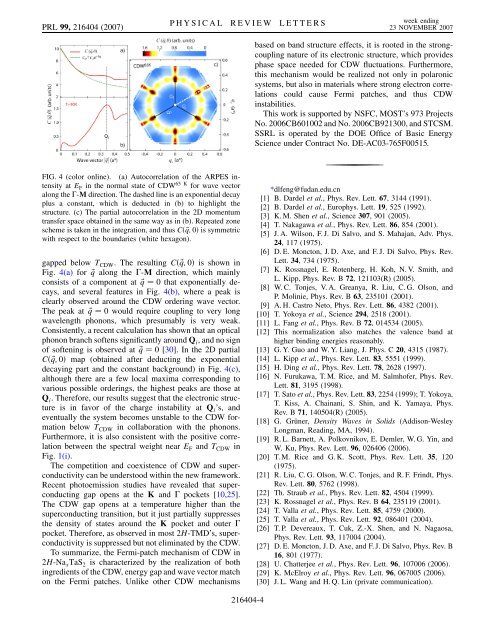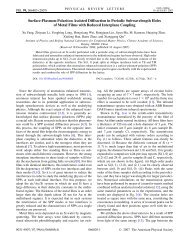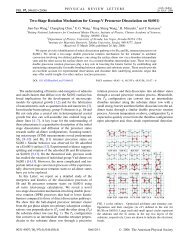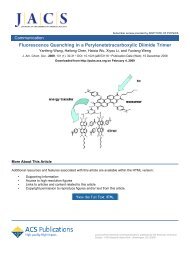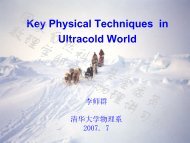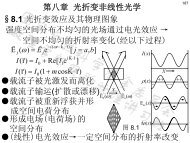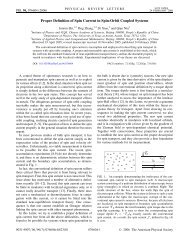Novel Mechanism of a Charge Density Wave in a Transition Metal ...
Novel Mechanism of a Charge Density Wave in a Transition Metal ...
Novel Mechanism of a Charge Density Wave in a Transition Metal ...
Create successful ePaper yourself
Turn your PDF publications into a flip-book with our unique Google optimized e-Paper software.
PRL 99, 216404 (2007)<br />
FIG. 4 (color onl<strong>in</strong>e). (a) Autocorrelation <strong>of</strong> the ARPES <strong>in</strong>tensity<br />
at E F <strong>in</strong> the normal state <strong>of</strong> CDW 65 K for wave vector<br />
along the -M direction. The dashed l<strong>in</strong>e is an exponential decay<br />
plus a constant, which is deducted <strong>in</strong> (b) to highlight the<br />
structure. (c) The partial autocorrelation <strong>in</strong> the 2D momentum<br />
transfer space obta<strong>in</strong>ed <strong>in</strong> the same way as <strong>in</strong> (b). Repeated zone<br />
scheme is taken <strong>in</strong> the <strong>in</strong>tegration, and thus C ~q; 0 is symmetric<br />
with respect to the boundaries (white hexagon).<br />
gapped below T CDW. The result<strong>in</strong>g C ~q; 0 is shown <strong>in</strong><br />
Fig. 4(a) for ~q along the -M direction, which ma<strong>in</strong>ly<br />
consists <strong>of</strong> a component at ~q 0 that exponentially decays,<br />
and several features <strong>in</strong> Fig. 4(b), where a peak is<br />
clearly observed around the CDW order<strong>in</strong>g wave vector.<br />
The peak at ~q 0 would require coupl<strong>in</strong>g to very long<br />
wavelength phonons, which presumably is very weak.<br />
Consistently, a recent calculation has shown that an optical<br />
phonon branch s<strong>of</strong>tens significantly around Q i, and no sign<br />
<strong>of</strong> s<strong>of</strong>ten<strong>in</strong>g is observed at ~q 0 [30]. In the 2D partial<br />
C ~q; 0 map (obta<strong>in</strong>ed after deduct<strong>in</strong>g the exponential<br />
decay<strong>in</strong>g part and the constant background) <strong>in</strong> Fig. 4(c),<br />
although there are a few local maxima correspond<strong>in</strong>g to<br />
various possible order<strong>in</strong>gs, the highest peaks are those at<br />
Q i. Therefore, our results suggest that the electronic structure<br />
is <strong>in</strong> favor <strong>of</strong> the charge <strong>in</strong>stability at Q i’s, and<br />
eventually the system becomes unstable to the CDW formation<br />
below T CDW <strong>in</strong> collaboration with the phonons.<br />
Furthermore, it is also consistent with the positive correlation<br />
between the spectral weight near E F and T CDW <strong>in</strong><br />
Fig. 1(i).<br />
The competition and coexistence <strong>of</strong> CDW and superconductivity<br />
can be understood with<strong>in</strong> the new framework.<br />
Recent photoemission studies have revealed that superconduct<strong>in</strong>g<br />
gap opens at the K and pockets [10,25].<br />
The CDW gap opens at a temperature higher than the<br />
superconduct<strong>in</strong>g transition, but it just partially suppresses<br />
the density <strong>of</strong> states around the K pocket and outer<br />
pocket. Therefore, as observed <strong>in</strong> most 2H-TMD’s, superconductivity<br />
is suppressed but not elim<strong>in</strong>ated by the CDW.<br />
To summarize, the Fermi-patch mechanism <strong>of</strong> CDW <strong>in</strong><br />
2H-Na xTaS 2 is characterized by the realization <strong>of</strong> both<br />
<strong>in</strong>gredients <strong>of</strong> the CDW, energy gap and wave vector match<br />
on the Fermi patches. Unlike other CDW mechanisms<br />
PHYSICAL REVIEW LETTERS week end<strong>in</strong>g<br />
23 NOVEMBER 2007<br />
216404-4<br />
based on band structure effects, it is rooted <strong>in</strong> the strongcoupl<strong>in</strong>g<br />
nature <strong>of</strong> its electronic structure, which provides<br />
phase space needed for CDW fluctuations. Furthermore,<br />
this mechanism would be realized not only <strong>in</strong> polaronic<br />
systems, but also <strong>in</strong> materials where strong electron correlations<br />
could cause Fermi patches, and thus CDW<br />
<strong>in</strong>stabilities.<br />
This work is supported by NSFC, MOST’s 973 Projects<br />
No. 2006CB601002 and No. 2006CB921300, and STCSM.<br />
SSRL is operated by the DOE Office <strong>of</strong> Basic Energy<br />
Science under Contract No. DE-AC03-765F00515.<br />
*dlfeng@fudan.edu.cn<br />
[1] B. Dardel et al., Phys. Rev. Lett. 67, 3144 (1991).<br />
[2] B. Dardel et al., Europhys. Lett. 19, 525 (1992).<br />
[3] K. M. Shen et al., Science 307, 901 (2005).<br />
[4] T. Nakagawa et al., Phys. Rev. Lett. 86, 854 (2001).<br />
[5] J. A. Wilson, F. J. Di Salvo, and S. Mahajan, Adv. Phys.<br />
24, 117 (1975).<br />
[6] D. E. Moncton, J. D. Axe, and F. J. Di Salvo, Phys. Rev.<br />
Lett. 34, 734 (1975).<br />
[7] K. Rossnagel, E. Rotenberg, H. Koh, N. V. Smith, and<br />
L. Kipp, Phys. Rev. B 72, 121103(R) (2005).<br />
[8] W. C. Tonjes, V. A. Greanya, R. Liu, C. G. Olson, and<br />
P. Mol<strong>in</strong>ie, Phys. Rev. B 63, 235101 (2001).<br />
[9] A. H. Castro Neto, Phys. Rev. Lett. 86, 4382 (2001).<br />
[10] T. Yokoya et al., Science 294, 2518 (2001).<br />
[11] L. Fang et al., Phys. Rev. B 72, 014534 (2005).<br />
[12] This normalization also matches the valence band at<br />
higher b<strong>in</strong>d<strong>in</strong>g energies reasonably.<br />
[13] G. Y. Guo and W. Y. Liang, J. Phys. C 20, 4315 (1987).<br />
[14] L. Kipp et al., Phys. Rev. Lett. 83, 5551 (1999).<br />
[15] H. D<strong>in</strong>g et al., Phys. Rev. Lett. 78, 2628 (1997).<br />
[16] N. Furukawa, T. M. Rice, and M. Salmh<strong>of</strong>er, Phys. Rev.<br />
Lett. 81, 3195 (1998).<br />
[17] T. Sato et al., Phys. Rev. Lett. 83, 2254 (1999); T. Yokoya,<br />
T. Kiss, A. Cha<strong>in</strong>ani, S. Sh<strong>in</strong>, and K. Yamaya, Phys.<br />
Rev. B 71, 140504(R) (2005).<br />
[18] G. Grüner, <strong>Density</strong> <strong>Wave</strong>s <strong>in</strong> Solids (Addison-Wesley<br />
Longman, Read<strong>in</strong>g, MA, 1994).<br />
[19] R. L. Barnett, A. Polkovnikov, E. Demler, W. G. Y<strong>in</strong>, and<br />
W. Ku, Phys. Rev. Lett. 96, 026406 (2006).<br />
[20] T. M. Rice and G. K. Scott, Phys. Rev. Lett. 35, 120<br />
(1975).<br />
[21] R. Liu, C. G. Olson, W. C. Tonjes, and R. F. Fr<strong>in</strong>dt, Phys.<br />
Rev. Lett. 80, 5762 (1998).<br />
[22] Th. Straub et al., Phys. Rev. Lett. 82, 4504 (1999).<br />
[23] K. Rossnagel et al., Phys. Rev. B 64, 235119 (2001).<br />
[24] T. Valla et al., Phys. Rev. Lett. 85, 4759 (2000).<br />
[25] T. Valla et al., Phys. Rev. Lett. 92, 086401 (2004).<br />
[26] T. P. Devereaux, T. Cuk, Z.-X. Shen, and N. Nagaosa,<br />
Phys. Rev. Lett. 93, 117004 (2004).<br />
[27] D. E. Moncton, J. D. Axe, and F. J. Di Salvo, Phys. Rev. B<br />
16, 801 (1977).<br />
[28] U. Chatterjee et al., Phys. Rev. Lett. 96, 107006 (2006).<br />
[29] K. McElroy et al., Phys. Rev. Lett. 96, 067005 (2006).<br />
[30] J. L. Wang and H. Q. L<strong>in</strong> (private communication).


